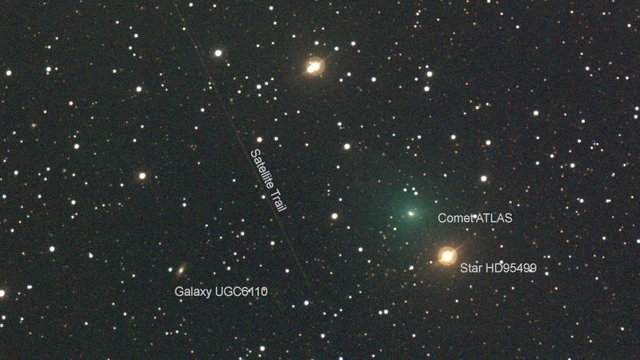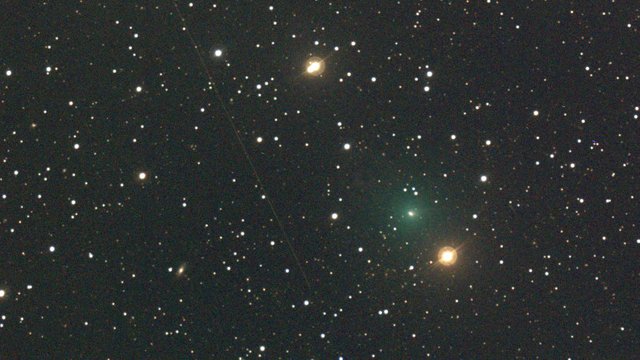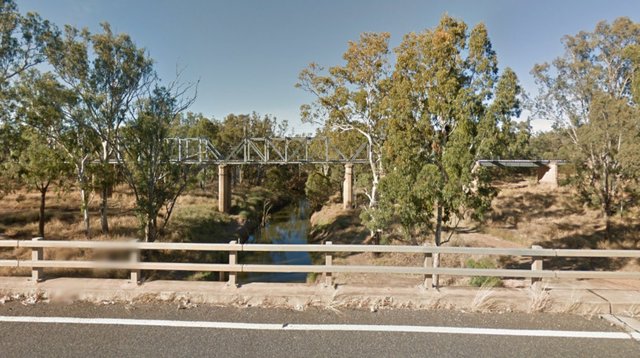
Comet C/2019 Y4 (ATLAS) on February 29, 2020. 4 x 2 minute exposures with RASA 28cm f2.2 telescope and ZWO ASI071MC Pro camera at Mayhill, New Mexico. Copyright Author
Yesterday I captured this image of Comet C/2019 Y4 (ATLAS) from a remote telescope in Mayhill, New Mexico, USA, a comet that astronomers will be keeping a close eye on over the coming months as it - hopefully - continues to brighten. In the image the comet appears clearly green (from diatomic carbon) and a couple of other objects have been labelled from a nearby satellite to a distant galaxy. Here is an un-annotated version.

A major interest point in Comet ATLAS is that it shares an almost identical orbit to that of a bright comet that was widely seen from the southern hemisphere 175 years ago during December, 1844. In fact, the town of Comet, 800km west of Brisbane, in the state of Queensland, Australia, was named in honor of the 1844 comet by German explorer Ludwig Leichhard. Leichhard, pioneered much of the early exploration of the interior of Australia and on in his travel diary mentions seeing a "fine comet" on the evening of December 28, 1844. The creek that he was exploring at the time thus became known as "Comet creek". Later, the town of Comet was built around this river.

Comet River. Fairuse: Google streetview
If Comet ATLAS and the 1844 Comet have the same orbit, are they the same comet? The answer is no, however, it seems the 2 comet's may have been sibling fragments from an ancient comet that split. Latest orbital calculation's show that the last return of Comet ATLAS was several thousand years ago and could not have been seen in 1844.
Depending on how the comet pan's out I plan to write a little more about it soon.
Meanwhile here is some further reading:
ATLAS (Asteroid Terrestrial-impact Last Alert System) homepage. http://fallingstar.com/home.php
Town of Comet homepage. https://centralhighlands.com.au/about/interactive-map/comet-queensland/
Ludwig Leichhard's travel memoirs - fascinating reading in itself. Comet Creek and the comet is mentioned at the end of Chapter 3. http://setis.library.usyd.edu.au/ozlit/pdf/p00050.pdf
A bit more information on Leichhard. https://en.wikipedia.org/wiki/Ludwig_Leichhardt
Hi @terrylovejoy.
I enjoyed this post. Especially the back story behind Leichhard, Comet Creek and how his fine comet might be a sibling to the one you've captured imagery of. Do you have any info on the progenitor comet that may have existed? Wouldn't viewing that comet break up be spectacular to see.
Thanks for supplying the links. I'm going to read up on some of Leichhard's memoirs as I settle in for the night.
Best,
Dave
Downvoting a post can decrease pending rewards and make it less visible. Common reasons:
Submit
Leichhard's memoirs make great reading actually, I got suckered into reading a couple of chapters myself :) Regarding the comet's progenitor it is looking like it returned too far in the past to make any identification.
Downvoting a post can decrease pending rewards and make it less visible. Common reasons:
Submit
Nice read Terry :-)
Yeah... a new target.
I must do a little bit of further read at the weekend.
Downvoting a post can decrease pending rewards and make it less visible. Common reasons:
Submit
This comet has some potential to get quite a bit brighter, but just waiting a little longer to see how things pan out. Perihelion is at the end of May when it will be quite close to the sun.
Downvoting a post can decrease pending rewards and make it less visible. Common reasons:
Submit
I wanted to ship my mount to a guy for maintenance this spring. Now I think it is better to delay this some weeks 😊
I need to look when it’s the best time for me (dark enough sky and close comet).
Downvoting a post can decrease pending rewards and make it less visible. Common reasons:
Submit
April through to near the end of May will be best for you. I will keep monitoring the comet, got it remotely again today and it seems to be continuing to brighten steadily and is showing some hope of being quite decent (as far as comets go). Definitely postpone the mount maintenance!
Downvoting a post can decrease pending rewards and make it less visible. Common reasons:
Submit
I've already postponed it to the summer :-)
Unfortunately, at the moment we have clouds and rain here. On Sunday it could be a little bit better until the weather will turn worse next week. Maybe I will have some luck on Sunday. Can I help you in some way by providing some images or something else?
Downvoting a post can decrease pending rewards and make it less visible. Common reasons:
Submit
Hey Kevin,the moon is a problem the next few days but in a week's time it will be interesting to see how it has developed. Would definitely be interested in any images you managed to get.
Downvoting a post can decrease pending rewards and make it less visible. Common reasons:
Submit
I will hope the best to get some luck with the weather. If so, I will send you the images.
Totally forgot about the moon with all the clouds here :-D
Downvoting a post can decrease pending rewards and make it less visible. Common reasons:
Submit
I enjoyed that write up, i am still learning to take night shots, it would be cool to get one of the comet. i still keep waiting for a clear night with some northern lights to try and capture, waiting is hard, missing the shots even harder, but I am learning. All I got of the Moon and Venus were blurry shots 4 or 5 days ago.
Downvoting a post can decrease pending rewards and make it less visible. Common reasons:
Submit
Getting focus is the first challenge, then keeping the phone steady is the next (i.e a tripod). What sort of camera/phone are you using?
Downvoting a post can decrease pending rewards and make it less visible. Common reasons:
Submit
I have gotten a couple of passable night shots of Orion recently. My camera is the Nikon D7500 and I am using an inexspensive 10-20mm zoom landscape lens. I just can not get the moon, I have also tried my 55-300mm zoom lens but even that it just comes out a blur never in focus. I do use a tripod, and I did read that for the moon you don't want to go more than 1/3 of a second. I'll keep trying, hoping that the temperatures begin to warm soon, I really do not like the single digit temperatures at all.
Downvoting a post can decrease pending rewards and make it less visible. Common reasons:
Submit
Keep at it! Try single point autofocus on the Nikon and the 55-300mm lens with the moon (this way you tell the camera exactly what to focus on). Start with your zoom lens set around 100mm with an aperture of f5.6, ISO1600 and 1/500th of a second. You should be able handhold this and get a good shot (i.e. you don't have to stay outside long!). Will be interested in how you get on - happy for you to post your image here and I will give feedback.
Downvoting a post can decrease pending rewards and make it less visible. Common reasons:
Submit
What an interesting story from that German guy. :)
I love that
Last Alarm systemreally speaks how things are getting "heated". Hopefully, it reaches our part of Solar system, and we see that magnificent double tails (through your pictures, of course:) )Enjoyed the read!
Downvoting a post can decrease pending rewards and make it less visible. Common reasons:
Submit
Yeh Leichardt was a legend, trekking 4800km across the top of Australia by foot! I can't imagine how oppressive the conditions were.
Downvoting a post can decrease pending rewards and make it less visible. Common reasons:
Submit
Congratulations @terrylovejoy! You have completed the following achievement on the Steem blockchain and have been rewarded with new badge(s) :
You can view your badges on your Steem Board and compare to others on the Steem Ranking
If you no longer want to receive notifications, reply to this comment with the word
STOPVote for @Steemitboard as a witness to get one more award and increased upvotes!
Downvoting a post can decrease pending rewards and make it less visible. Common reasons:
Submit
Hello,
Your post has been manually curated by a @stem.curate curator.
We are dedicated to supporting great content, like yours on the STEMGeeks tribe.
Please join us on discord.
Downvoting a post can decrease pending rewards and make it less visible. Common reasons:
Submit